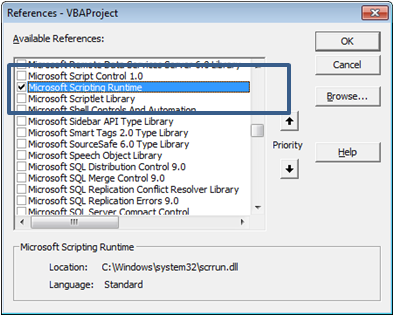Option ExplicitOption Compare Text
Sub GetFrequency()
Dim Coll As New Collection
Dim var, k
Dim cel As Range
Dim aName As Variant
Dim sTemp$
Dim rng As Range
Dim dName As New Scripting.Dictionary
Dim n&, i&
'add full names to collection
'NOTE: in next line, change the number 1 to the column number of your names
'Example: if your data is in column D, change the 1 to a 4
Set rng = Range(Cells(2, 1), Cells(2, 1).End(xlDown))
For Each cel In rng.Cells
Coll.Add UCase(cel)
Next cel
'names stored, now delete range
rng = ""
'create dictionary of individual names and frequency within collection
For Each var In Coll
sTemp = Trim(var)
aName = Split(sTemp, " ")
For n = LBound(aName) To UBound(aName)
If dName.exists(aName(n)) Then
dName(aName(n)) = dName(aName(n)) + 1
Else
dName.Add Key:=aName(n), Item:=1
End If
Next n
Next var
'sort dictionary in order of name frequency
Call SortDictionaryByItem(dName, True)
n = 1
'print results to column A
For Each k In dName.Keys
For i = Coll.Count To 1 Step -1
If InStr(1, Coll(i), k) > 0 Then
rng(n, 1) = Coll(i)
Coll.Remove i
n = n + 1
End If
Next i
dName.Remove (k)
Next k
End Sub
Sub SortDictionaryByItem(Dict As Scripting.Dictionary, Optional bDescending As Boolean)
'code modified to work with other subs
'from http://www.xl-central.com/sort-a-dictionary-by-item.html
'in calling sub, need to set the comparison mode to perform a textual comparison
'Dict.CompareMode = TextCompare
' Dictionary using Early Binding
'Set a reference to Microsoft Scripting Runtime by using
'Tools > References in the Visual Basic Editor (Alt+F11)
'Declare the variables
Dim arr() As Variant
Dim Temp1 As Variant
Dim Temp2 As Variant
Dim Txt As String
Dim i As Long
Dim j As Long
'Allocate storage space for the dynamic array
ReDim arr(0 To Dict.Count - 1, 0 To 1)
'Fill the array with the keys and items from the Dictionary
For i = 0 To Dict.Count - 1
arr(i, 0) = Dict.Keys(i)
arr(i, 1) = Dict.Items(i)
Next i
'Sort the array using the bubble sort method
For i = LBound(arr, 1) To UBound(arr, 1) - 1
For j = i + 1 To UBound(arr, 1)
If arr(i, 1) > arr(j, 1) Then
Temp1 = arr(j, 0)
Temp2 = arr(j, 1)
arr(j, 0) = arr(i, 0)
arr(j, 1) = arr(i, 1)
arr(i, 0) = Temp1
arr(i, 1) = Temp2
End If
Next j
Next i
'Clear the Dictionary
Dict.RemoveAll
'Add the sorted keys and items from the array back to the Dictionary
If bDescending = True Then
For i = UBound(arr, 1) To LBound(arr, 1) Step -1
Dict.Add Key:=arr(i, 0), Item:=arr(i, 1)
Next i
Else
For i = LBound(arr, 1) To UBound(arr, 1)
Dict.Add Key:=arr(i, 0), Item:=arr(i, 1)
Next i
End If
End Sub






